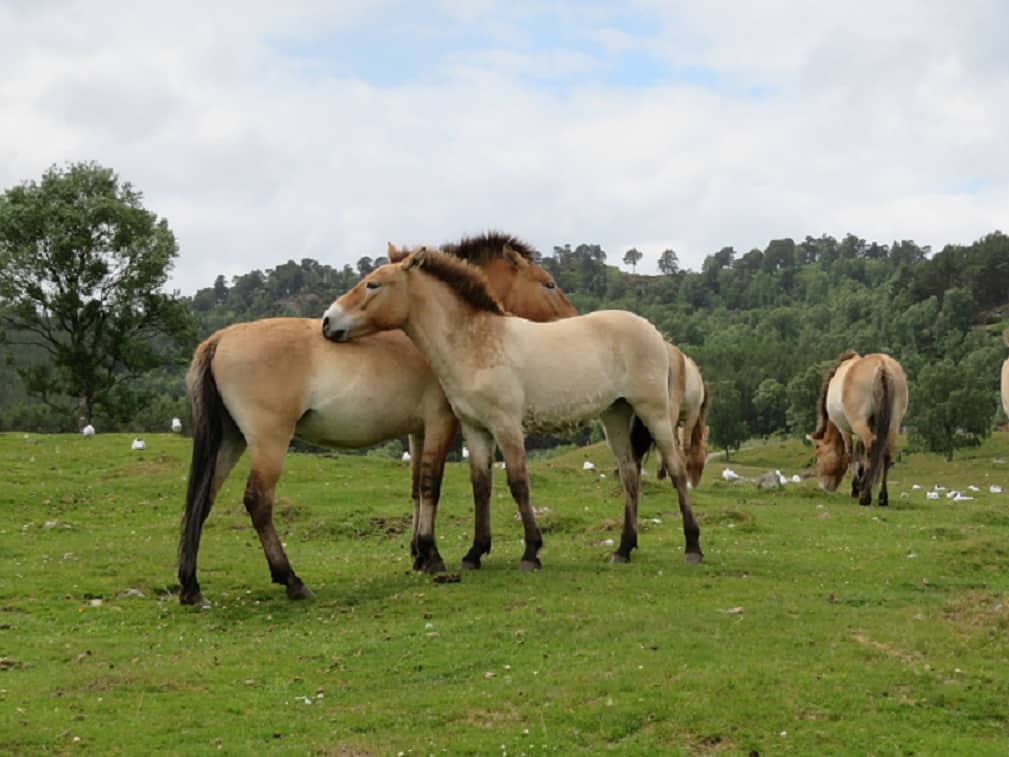
They’re wild horses discovered by Nikolai Przewalski, a Polish-born colonel in the Russian Army, on an 1878 exhibition to the Mongolian-Chinese frontier. The colonel named the horses after himself.

They are also referred to as takhi, the Mongol word for “spirit.”
By either name, these are true wild horses, never trained by man, but always roaming on the Central Asian steppes at their will.
Mustangs, Brumbies, and other horses living free are actually feral; horses descended from those who escaped their bonds or were turned loose. “If other horses are the equivalent of feral dogs, then the Przewalski’s horse is a wolf,” says Rachel Nuwer. Read her fabulous Nova/PBS article Saving the World’s Only True Wild Horses here.
From nearly extinct, herds are being brought back, returning to Mongolia and other locations around the world, including the “living collection” of seventeen mares, foals, and a stallion at the Highland Wildlife Park in Cairngorms National Park. The herds are looking strong due to careful genetic choices and improved care practices.
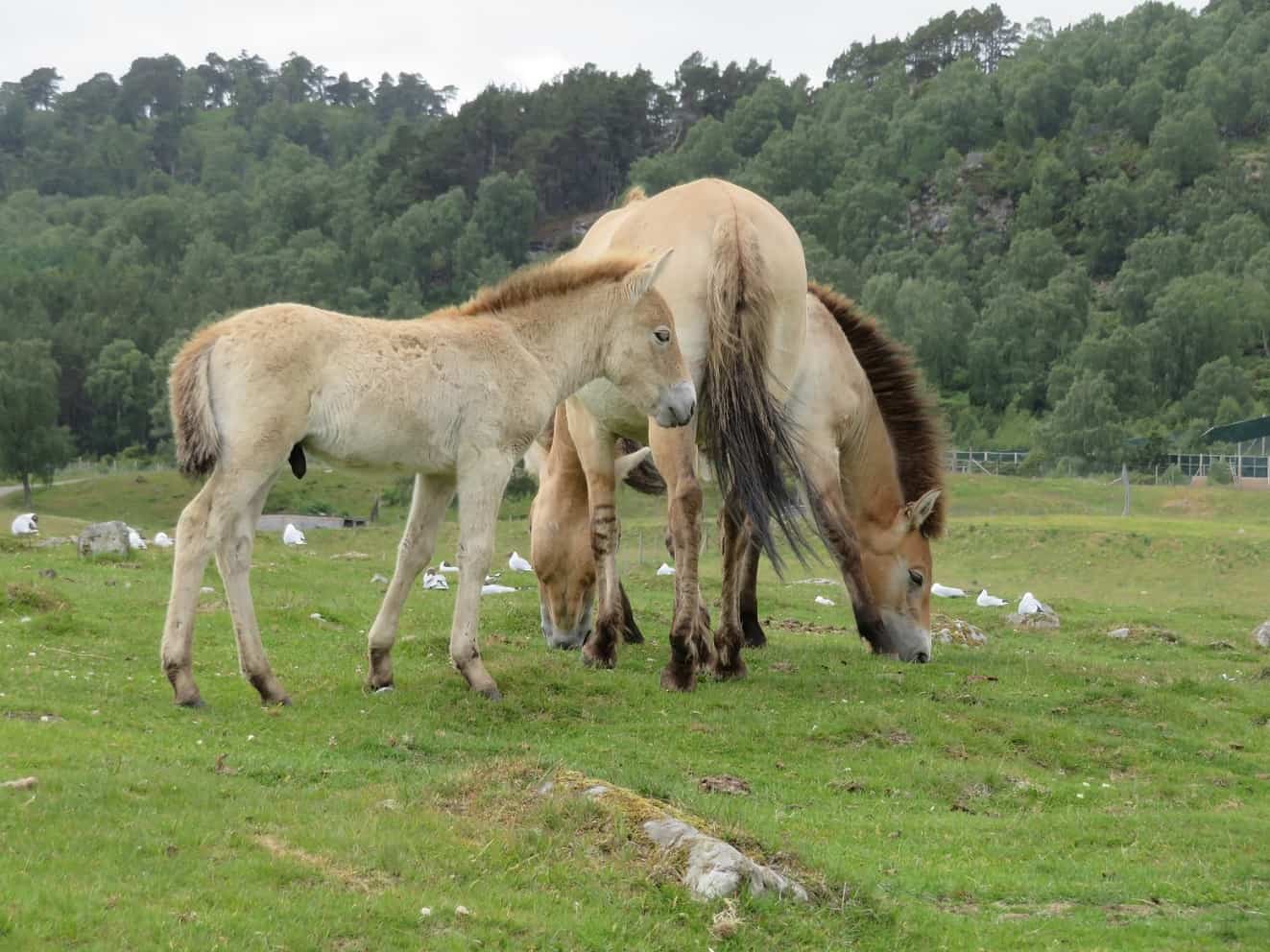
Imagine getting an email from Bonny Mealand, an equine podiatrist specializing in working with wild, feral, or unhandled horses. She wonders if you might have spare time and would like to visit the herd? I responded within seconds, even before the shrieking died down.
I think humans have been hooked on horses since they started painting their images on cave walls. And the first paintings looked just like takhis.
What would they be like? Perhaps the truest of horses; before we put them to the plow, before we made up romantic stories about them, before they became our partners or beasts of burden or healers. What were horses like before we changed their lives?
This herd lives on eighty acres, shared with some deer and bison, in a protected area. It’s a wildlife park where cars may drive through slowly, people caged in vehicles, and the animals wandering free. I liked it already.
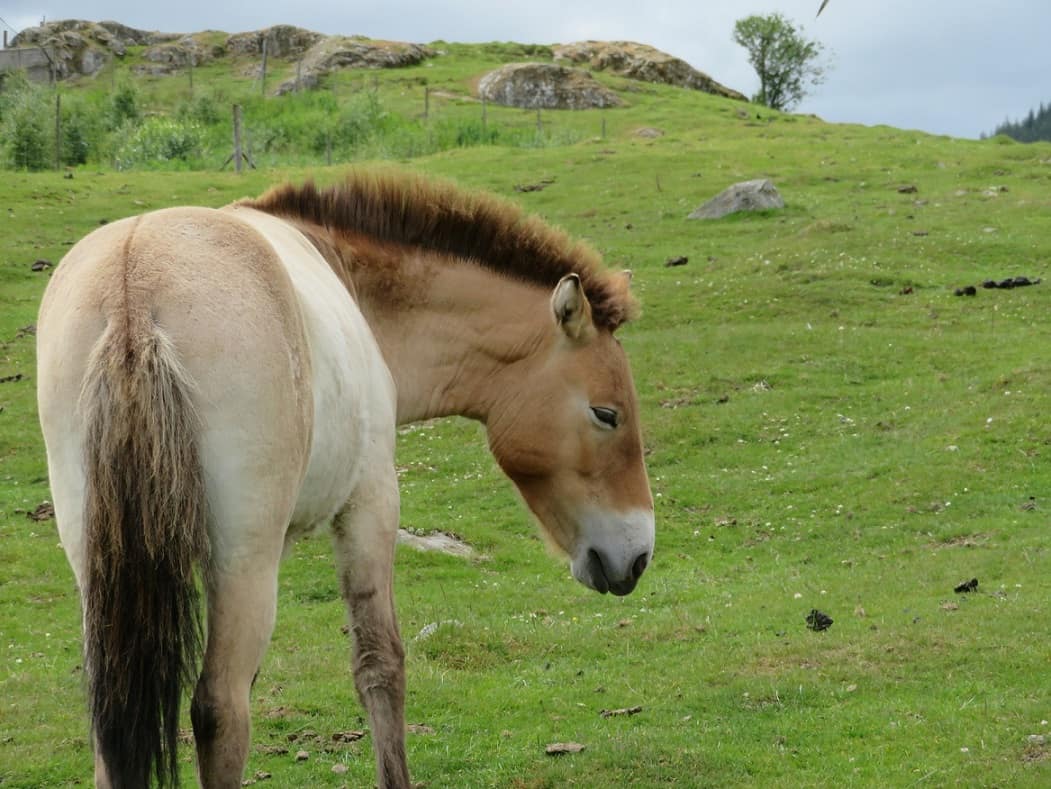
The herd is established and growing, safely beyond the reach of predators, except for those in charge of their care. Traditionally, the accepted approach was to dart and tranquilize animals when they were in need of medical help. It had a traumatic effect, sometimes even injuring them.
It’s complicated: These precious horses, truly wild takhis, must accept some help from humans but can we find a less stressful method? Is there a way to maintain their instincts but allow some human handling in a positive way?
Sounds a bit familiar, right? Trying to keep a horse in the most natural way possible, but still get them the care and security needed to keep them safe, in alignment with their reality as a flight animal. Isn’t that the work we try to manage at our own barns?
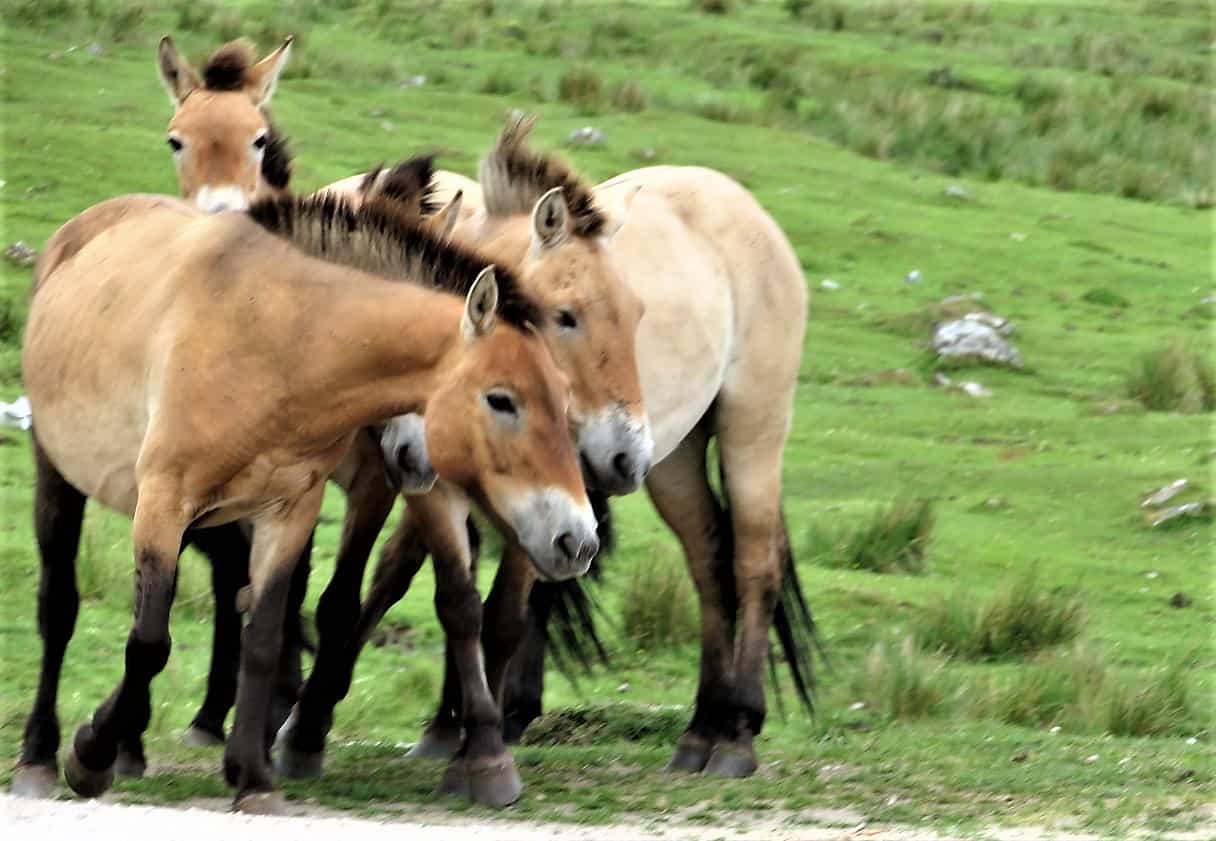
Enter Bonny, with the help of zoo employees, and the idea to try another way. Clicker training is a common approach that zoos employ, but this situation called for something else. Using a group of pens, the Przewalski’s are lured in with carrots and turnips tossed on the ground. They move through pens, stalls of a barn, and eventually a chute, by just following the herd. Before then, any enclosure at all caused panic but this method of inviting, rather than chasing from behind, created a quiet opportunity. Now the zoo could contain the herd safely if needed.
There is a middle pen, and if they choose, horses may enter, with larger groups visible through gates on either side. In that central pen, the horses are given special meals, along with a touch, eventually followed by scratching, rubbing and even a hand down their leg. The horses are allowed to leave when they show any anxiety. Soon, one or two horses began to get familiar enough to stand without halters, some hooves that badly needed trimming got help from Bonny. There was no restraint and the takhi had a choice. It was a more peaceful and safe approach for both humans and horses.
Does the method ruin the “wildness” of the herd or ensure its future?
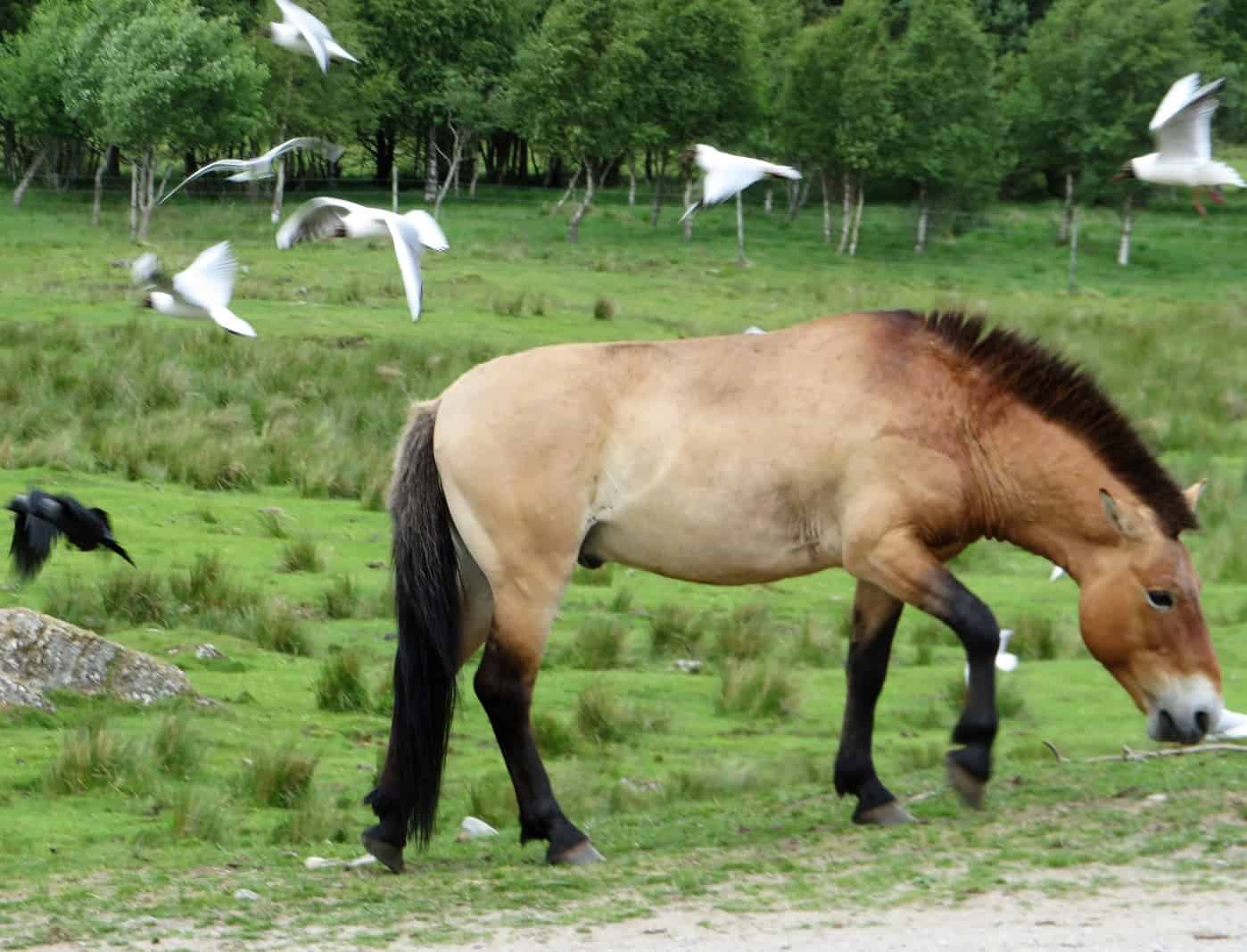
I confess, the stallion, Chagatai (the name of one of the sons of Genghis Khan), had a magnetic presence. As a youngster, he was part of a horrific fight in a bachelor herd. He managed to survive but paid a price. He was badly injured, losing an eye and sustaining a very damaged jaw with missing teeth. His body bore the scars and he appeared older than his eleven years. He strolled to the tall gate by the central pen as I stood on the other side. As he passed, his blind side toward me, he seemed to sense me in a way I’d experienced one-eyed domestic horses do in the past. It’s as if they take stock with the un-seeing eye. He turned, came back and stopped, looking with his good eye, letting his ears relax to a lateral position. Did he just give me a calming signal?
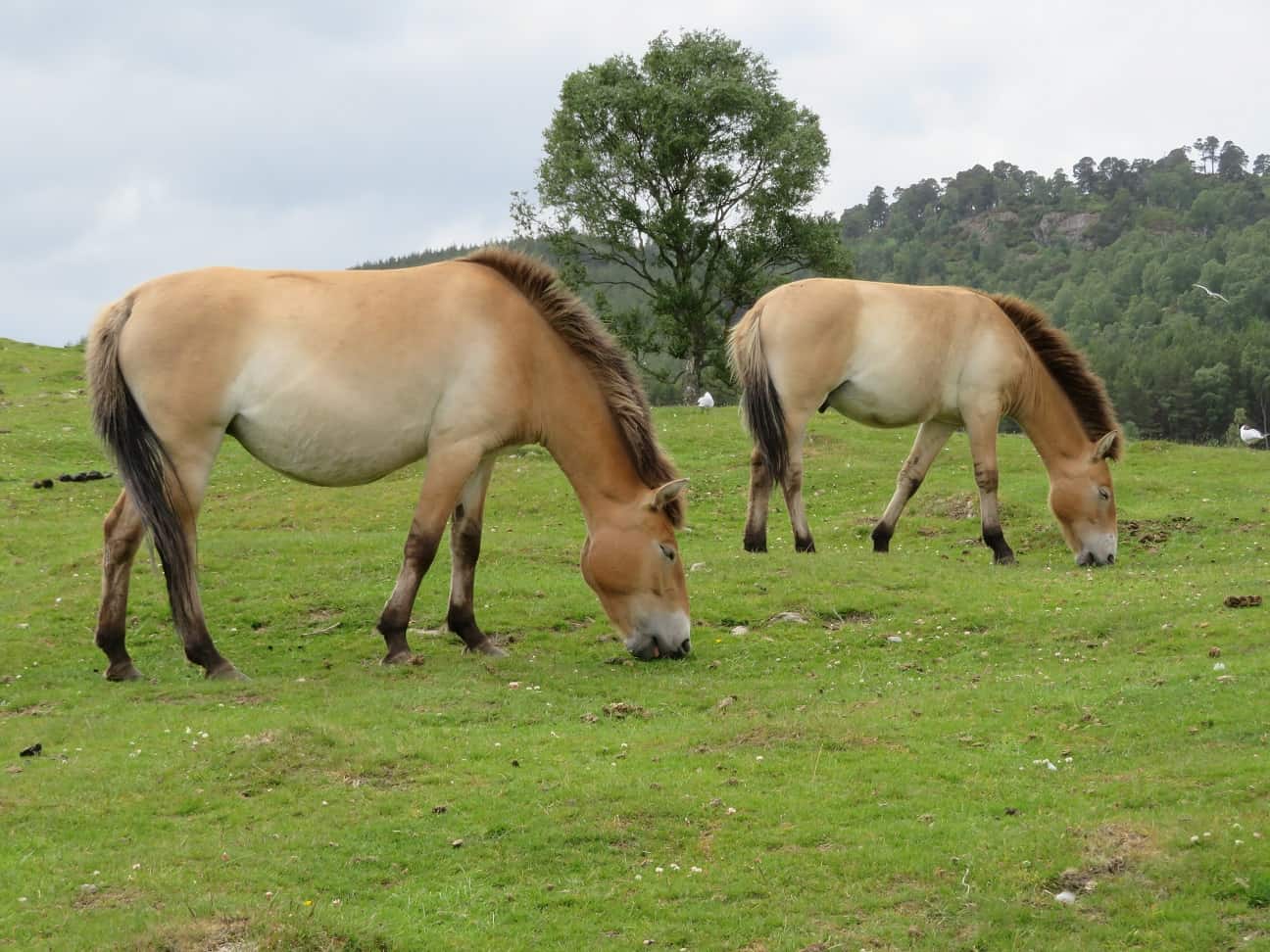
A young male came to the far end of the gate and stood to look at us on the inside. Chagatai had a job to do, so he moved to the young horse quietly and with a flick of his ear, the young horse blinked, narrowed his eyes, and moved away from the gate. It was an interchange without aggression, just a request answered. The kind stallion gave a small yawn as he returned to his previous spot with what some might call the countenance of an old soul. Deep sigh.
The more I looked at him, the more he reminded me of a lion; he had that massive confident grace. It was impossible to not share the respect his herd felt for him.
Wild Przewalski’s horses are proud. The mares are canny and the youngsters bold. That day, I noticed fewer signs of stress than many of their domestic cousins. At the park, foals wander through the herd under the eye of the elders and their human caregivers. For all their history of independence, the Przewalski’s have more in common with our domestic horses and donkeys than I expected. It’s easy to see the wildness in both, as well as the intellect and shared language.
I hope our species will continue to be creative in the ways of using less force and domination in working with all kinds of horses. That we will hold that, given a fair opportunity, these sentient creatures would choose to be a willing partner in their future.

Oh wow! Literally awesome.
And truly Anna, you’ve earned that experience.
If you were able to spend a week with them, that would be the basis for your next Book. 🙂
Annie, it was amazing and at the same time, so natural… thanks.
Oh wow! Literally awesome.
And truly Anna, you’ve earned that experience.
If you were able to spend a week with them, that would be the basis for your next Book. 🙂
Funny how life works: I just watch a documentary on the work of Temple Grandin towards developing animal welfare methods at farms and slaughter houses and what you describ looks very similar!
Yes, she is a wizard on this… thank you!
Fabulous blog, this one! Thank you for this informative, loving, and yes, exciting story.
Thanks, it was such a thrill to be there.
Wow. Thank you for sharing your experience with us. Looks amazing, and no one more deserving than you to have that privilege .
Thanks, Sarah. It is a precious thing in this crazy world…
Wow. Thank you for sharing your experience with us. Looks amazing, and no one more deserving than you to have that privilege .
Thanks, Sarah. It is a precious thing in this crazy world…
‘He moved the young horse quietly, with a flick of his ear’ …. thank you so much, Anna, for introducing us to their ‘calming’ signals at Tullich yesterday – so much experienced in raising our consciousness with ‘time’ and ‘spacial awareness’ !
Delightful meeting you, Minty. When I’m far from home, I always feel closer to my herd when I see calming signals in the horses here… but this felt like a message from centuries ago. They are such a treasure. Thanks, and wow. Tullich!
Thank you for sharing this wonderful experience.
“this felt like a message from centuries ago”…
Yes, indeed. I was just thinking about genetic memory and if that was the reason that I have wanted a Fjord since I could remember and in light of the DNA testing that indicated we are 41% Scandinavian, 38% Irish/Scottish. Some things just FEEL a way that is familiar and right and timeless.
I am not a good rider and I’m not a trainer, but I wholeheartedly agree on striving to communicate and work with horses in ways that are much less stressful than what is generally considered to be the norm. I have successfully taught a drafty Fjord and am well on my way with my second Fjord, to not pull me around and put their heads down to graze (you can’t get those thick necks up once they get them down) just by giving them what they want, which is to put their head down and graze, along with a verbal cue. Operant conditioning, I believe it’s called. My new girl is beginning to trust that I’m going to tell her, “head down” and she’s going to mow the lawn. No pain, no pulling, no sweating and potty mouth on my part. No whips, no chasing, no ropes, no scaring her.
Sounds like you are on the right path. Thanks for commenting, Susie.
How wonderful that you were able to be a part of these horses’ lives for a short while! The pictures, your descriptions of the horses’ interactions with each other and their human care-givers gave a sense of hope for the survival of these unique animals. Thanks for sharing.
Susan, that’s it. Hope is a precious thing and for those of us who love horses, it might have been a Mecca. Thanks.
I loved reading about your experience; can only imagine how much more you loved living it!
It was a funny combination of totally magical and the most ordinary thing… in other words, Horses. Thanks, Michelle
When I was a child there were several Przewalski’s horses in the Brookfield Zoo. We didn’t visit very often but they were my favorite residents followed by the zebras. It really wasn’t the best place for them, very confined for a creature born of open places. I understood they were endangered and the zoo was trying to breed them. I think this is a much better place and method. I’m so glad you got the chance to meet them.
It’s that imperfect balance, isn’t it? Talking with Bonny, it’s that trade off; if they are to be saved, we end up changing them… Thanks, Aquila
When I was a child there were several Przewalski’s horses in the Brookfield Zoo. We didn’t visit very often but they were my favorite residents followed by the zebras. It really wasn’t the best place for them, very confined for a creature born of open places. I understood they were endangered and the zoo was trying to breed them. I think this is a much better place and method. I’m so glad you got the chance to meet them.
Curious: https://www.reuters.com/article/us-science-horse/worlds-last-remaining-wild-horses-arent-really-wild-after-all-idUSKCN1G7034
Thanks, Lytha. Their research will continue and so will mine. I only care that these takhi get a chance…
Curious: https://www.reuters.com/article/us-science-horse/worlds-last-remaining-wild-horses-arent-really-wild-after-all-idUSKCN1G7034
What a spectacular experience. I am so happy for you. Of all the people who could bring meaning to meeting the Przewalski horses in this setting, you are most deserving. Thank you for sharing the experience with us.
Jean, great meaning to me, but not a thing to them… as is true of most horses. They always seem to mean more to us than we do them. But you would love them, too. Standing there was more than perfect. Thank you, hope you are well.
What a privilege to meet the Przewalski horses. How fortunate are you!
I guess there’s genetically wild, and behavior-ly wild. (is this a word?) Populations that live undomesticated and interbreed fit the bill of wild to me…
We have several populations of horses descended from shipwrecked Spanish galleons living here on the Outer Banks, on Assateague + Chincoteague in Va, and I believe some on Cumberland Island, Georgia as well. The local horses have one less vertebra than “regular” horses do.
I have had the pleasure of caring for and riding two of the Outer Banks versions (born in the captive breeding program). Both mares. They are wickedly smart and therefore even more challenging than usual lol.
There is a different quality, you are right, to those sorts. I’ve known some amazing “free roaming” horses. Beyond smart, is right.
That is nice…quite the opposite of the “Dutch “wild” horses”…originally Konik horses. Living with deers and Herford cows at the Oostvaardersplassen in the Netherlands. Mainly swamp area. No feed/grass in the winter. Animals dying a horrible dead. No extra hay should be provided as…horses live on the fat they built up in sommer.. No extra hay because this is “Nature”…. with a nice fence around it so they cannot wander to other nature area’s.
So frustrated that this is happening and nothing can be done. Every attempt to turn the faith of these animals is immediately put down.
Sad to hear, it must be horrible to see. So wish there was help.
That is nice…quite the opposite of the “Dutch “wild” horses”…originally Konik horses. Living with deers and Herford cows at the Oostvaardersplassen in the Netherlands. Mainly swamp area. No feed/grass in the winter. Animals dying a horrible dead. No extra hay should be provided as…horses live on the fat they built up in sommer.. No extra hay because this is “Nature”…. with a nice fence around it so they cannot wander to other nature area’s.
So frustrated that this is happening and nothing can be done. Every attempt to turn the faith of these animals is immediately put down.
wOW. Just Wow…. Thanx for sharing.
Thanks, Sally.
What a fabulous educational and memorable experience! So cool! =-)
Lucky to be there for sure, Deb. 🙂
Can you please change my email for your posts to – [email protected]
Thanks! Cheryl
So sorry. I can’t on this end. You can on the top right column. Thanks.
The Przewalski horses have always fascinated me; how lucky for you to have met them “close and personal”
especially in Scotland which I love! Thanks for sharing this experience with us – just awesome!
Trudi, they ARE fascinating! Amazing to be here!
The Przewalski horses have always fascinated me; how lucky for you to have met them “close and personal”
especially in Scotland which I love! Thanks for sharing this experience with us – just awesome!
Thank you so much, Anna, for sharing this beautiful experience and your insight!
They are so special… thanks, Carolyn